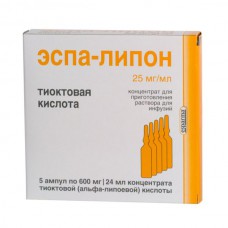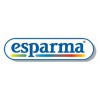Expiration date: 01/2026
Composition
Concentrate for solution for infusion
Active substance (per 1 ml):
ethylenediamine salt of ?-lipoic acid, 32.3 mg (Corresponding to 25 mg of thioctic (?-lipoic acid))
Excipients: Water for Injection
The drug forms
Concentrate for solution for infusion: clear solution is greenish-yellow in color.
pharmachologic effect
Mode of action - metabolic, antioxidant.
Pharmacodynamics
Thioctic (?-lipoic acid) - an endogenous antioxidant. As coenzyme mitochondrial multienzyme complexes involved in the oxidative decarboxylation of pyruvic acid and ?-keto acids, plays an important role in the energy balance of the body. By the nature of the biochemical action similar to the group of vitamin B.
It has hepatoprotective, hypolipidemic, cholesterol-lowering, the hypoglycemic effect. Participates in the regulation of lipid and carbohydrate metabolism, has a lipotropic effect, effect on cholesterol metabolism, improves liver function, has a detoxification effect in cases of poisoning by salts of heavy metals and other toxic states. Effects on carbohydrate metabolism is expressed in reducing the concentration of glucose in blood and increasing in liver glycogen, as well as overcoming insulin resistance. Improves trophic neurons.
Pharmacokinetics
When ingestion rapidly and completely absorbed in the digestive tract, concomitant use with food reduces the absorption. Bioavailability - 30-60% due to the effect of the first passage through the liver. Tmax - 25-60 minutes.
The on / in the introduction Cmax of 25-38 ug / ml, Tmax - 10-11 min, AUC - about 5 mcg · h / mL. Bioavailability - 30%.
It has the effect of the first passage through the liver. It is metabolized in the liver by side chain oxidation and conjugation. Vd - 450 ml / kg. Total clearance - 10-15 ml / min. Thioctic acid and its metabolites are excreted by the kidneys (80-90%). T1 / 2 - 20-50 minutes.
Testimony:
- diabetic neuropathy;
- Alcoholic polyneurop
Contraindications
- Hypersensitivity to the drug;
- pregnancy;
- breastfeeding (not enough experience with the drug);
- Children up to age 18 years (effectiveness and safety have not been established).
Side effects
Perhaps the development of allergic reactions (hives, skin rash, pruritus, and systemic allergic reactions - until the development of anaphylactic shock), hypoglycemia (due to improved glucose uptake), whose symptoms include dizziness, increased sweating, headache, blurred vision.
The on / in the introduction is very rarely - seizures; diplopia; petechial hemorrhages in the mucous membranes, the skin; thrombocytopathy; purpura (purpura), thrombophlebitis; the rapid introduction - increase in intracranial pressure (a sense of heaviness in the head); difficulty breathing.
If ingestion is very rare (<1/10000), you experience the following side effects: nausea, heartburn, vomiting, diarrhea, abdominal pain.
Interaction
While the use of insulin or oral hypoglycemic agents gain hypoglycemic effect is observed.
When concomitant administration of thioctic acid and cisplatin marked decrease in the efficiency of cisplatin.
Ethanol and its metabolites weaken the effect of thioctic acid.
Additionally for concentrate for solution for infusion
Thioctic (?-lipoic acid) forms with sugar molecules (e.g. levulose solution) sparingly soluble complex compounds thus incompatible with the glucose solution, Ringer's solution, as well as compounds (including solutions thereof), and interacting with SH- disulfide groups.
Dosing and Administration
A solution for infusion is prepared from a concentrate by dilution with isotonic sodium chloride solution.
Severe forms of diabetic polyneuropathy or alcohol. 1 time per day in the form of / drip infusions in 24 ml of a solution of 250 ml of isotonic sodium chloride solution (corresponding to 600 mg ?-lipoic acid per day). The drug is recommended for 2-4 weeks. Infusion solutions should be administered within 50 min.
Prepared solutions should be stored in a dark place and use as much as possible within 6 hours after preparation.
This is followed by maintenance therapy go in the form of pills at a dose of 600 mg / day. Minimum course of taking the tablets - 3 months. In some cases, the drug requires more long-term use, the terms of which are determined by the attending physician.
Overdose
Symptoms include headache, nausea, vomiting.
Treatment: symptomatic. No specific antidote.
Special instructions
In patients with diabetes, especially early in treatment, requires frequent monitoring of blood glucose concentration. In some cases, a reduction in the dose of hypoglycemic agents.
During treatment should strictly abstain from alcohol.
Additionally for concentrate for solution for infusion
The product is light sensitive, so the vial should get out of the package just before using.
In addition to tablets, film-coated
Effects on ability to drive or to perform work requiring higher rate of physical and mental reactions. The drug has no effect on the ability to drive vehicles and operate machinery that require attention.
Release Form
Concentrate for solution for infusion. 12 or 24 ml in a dark glass ampoules. 5 vials in plastic trays. 1 (Amp. 12 ml) or 2 (Amp. 24 ml) was placed in a plastic tray carton pack.
Manufacturer
Esparma GmbH Zeepark, 7, 39116 Magdeburg, Germany.
Storage conditions
In the dark place at a temperature no higher than 25 ° C.
Keep out of the reach of children.
The shelf life
3 years.
Do not use beyond the expiration date printed on the package.



